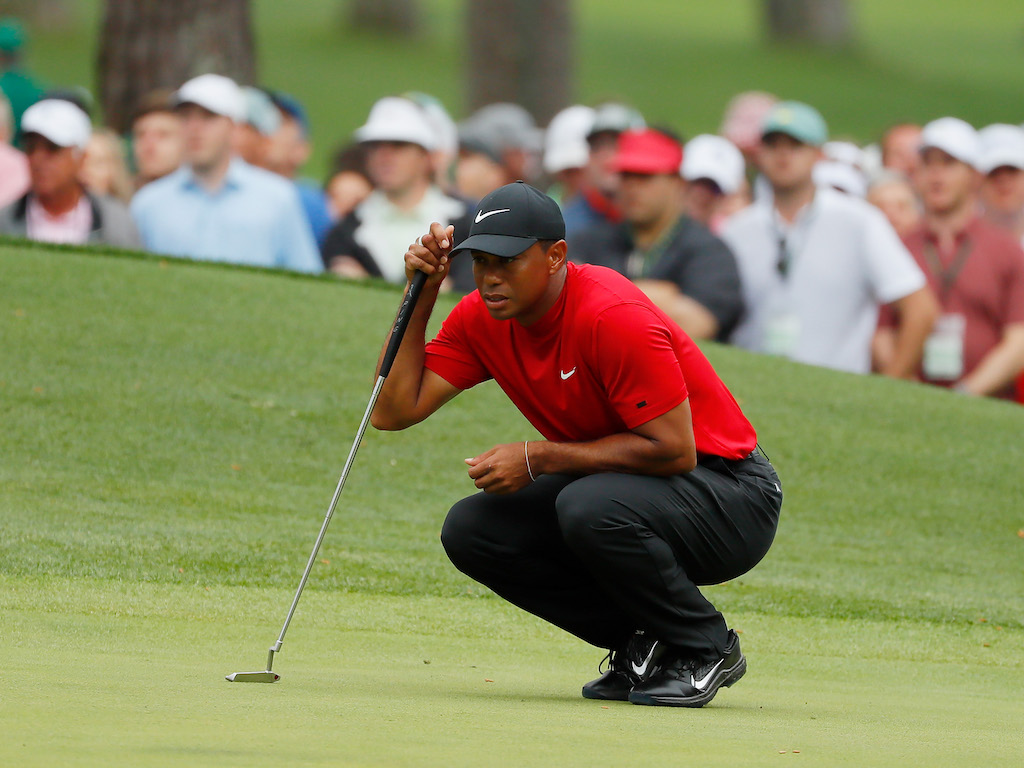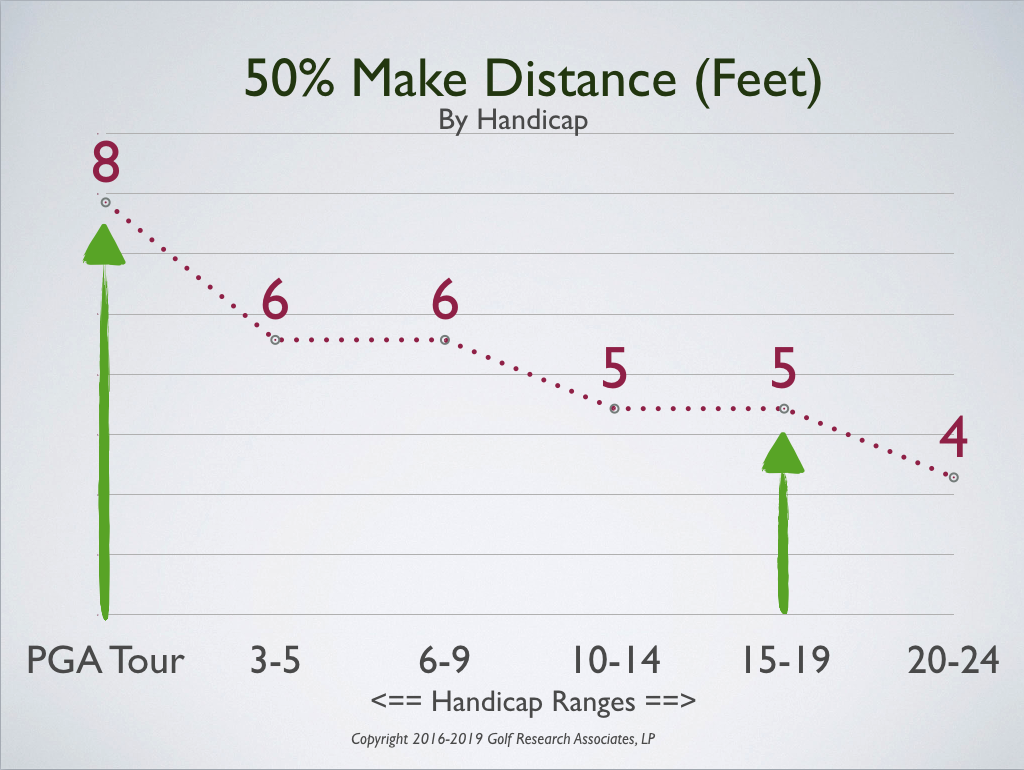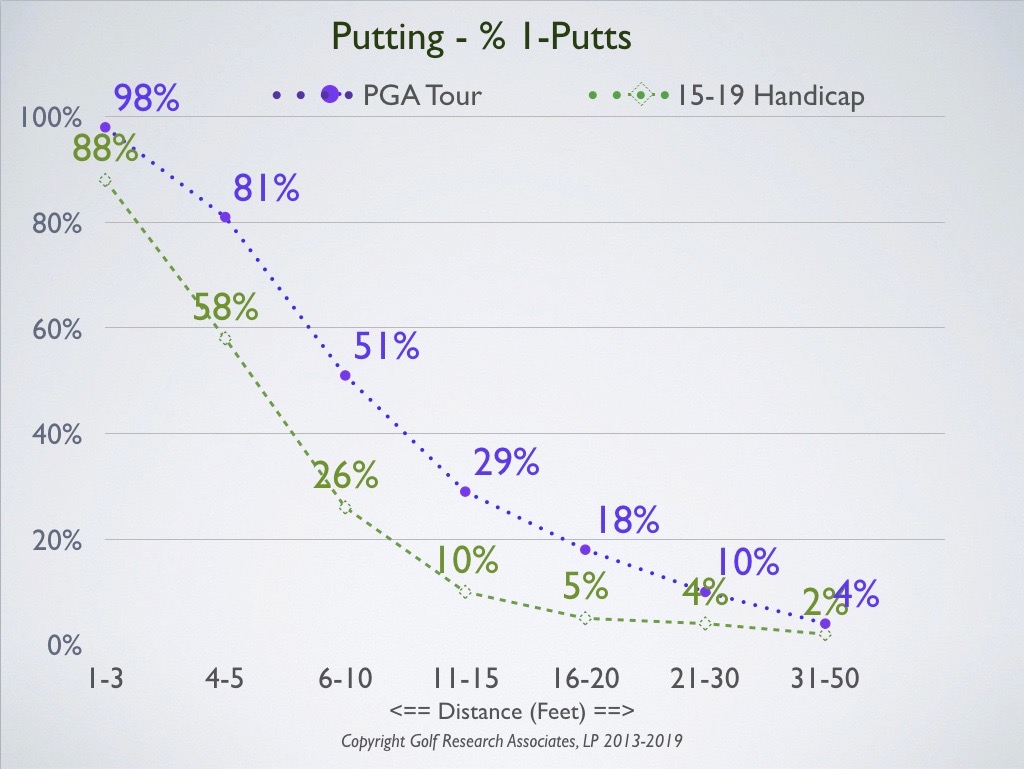Opinion & Analysis
When the data says line is more important than speed in putting

In my recent article, Line vs. speed: What’s really more important in putting?, I pointed out that in my 30-plus years of studying putting performance, I’ve learned that there are two important skills to putting:
- Direction (line)
- Distance control (speed)
There’s no question that golfers need to possess both these skills, but contrary to popular belief, they are not equally important on all putts. Sometimes, speed should be the primary concern. In other situations, golfers should be focused almost entirely on line. To make this determination, we have to consider the distance range of a putt and a golfer’s putting skill.
In the above referenced article, I showed how important speed is in putting, as well as the distances from which golfers of each handicap level should become more focused on speed. As promised, I’m going to provide some tips on direction (LINE) for golfers of different handicap levels based on the data I’ve gathered over the years through my Strokes Gained analysis software, Shot by Shot.
When PGA Tour players focus on line
On the PGA Tour, line is more critical than speed from distances inside 20 feet. Obviously, the closer a golfer is to the hole, the more important line becomes and the less need there is to focus on speed. Further, I have found that the six-to-10-foot range is a key distance for Tour players. Here are three reasons why:
- Six to 10 feet is one of the most frequently faced putt distances on the PGA Tour. It is the first putt distance on approximately one in every five greens.
- Smack in the middle of this range is eight feet, which is the distance from which the average PGA Tour player makes 50 percent of his putts.
- In my research, I have consistently found that one-putt success in the six-to-10-foot range separates good putters from the rest on the PGA Tour
What we should do
How does this analysis help the rest of us? To answer that question, we must first know our one-putt distance. Just as I showed the two-putt distance by handicap level here, I will now show the 50 percent make distance by handicap level. This is the distance from the hole where players at each handicap level make 50 percent of their putts.

My recommendation is for each of us to recognize exactly what our 50 percent distance is. Maybe you’re a 16 or 17 handicap and putting is one of your strengths. Your 50 percent make distance is six feet. Excellent! From that distance and closer, you should focus on line and always give the ball a chance to go in the hole. From distances of seven-plus feet, you should consider the circumstances (up or downhill, amount of break, etc.) and factor in the speed as appropriate. The goal is to make as many of these putts as possible, but more importantly, avoid those heart-breaking and costly three-putts.
For added perspective, I am including the percentage of one putts by distance for the PGA Tour and our average amateur 15-19 handicap. I’m able to offer this data from ShotbyShot.com because it provides golfers with their “relative handicap” in the five critical parts of the game: (1) Driving, (2) Approach Shots, (3) Chip/Pitch Shots, (4) Sand Shots, and (5) Putting.

Line control practice: The star drill
Looking for a way to practice choosing better lines on the putting green? Here’s a great exercise known as the “star drill.” Start by selecting a part of your practice green with a slight slope. Place five tees in the shape of a star on the slope with the top of the star on the top side of the slope. This will provide an equal share of right to left and left to right breaks.
I recommend starting with a distance of three feet – usually about the length of a standard putter. See how many you can make out of 10 putts, which is two trips around the star. Here are a few more helpful tips.
- Place a ball next to each of the five tees.
- Use your full pre-shot routine for each attempt.
- Stay at the three-foot distance until you can make nine of 10. Then, move to four feet, five feet, and six feet as you’re able to make eight from four feet, seven from five feet, and six from six feet.
This drill will give you confidence over these very important short putts. I do not recommend using it for any distance beyond six feet. It’s harder than you think to get there!
Exclusive for GolfWRX members: For a free, one-round trial of Shot by Shot, visit www.ShotByShot.com.
- LIKE103
- LEGIT8
- WOW4
- LOL1
- IDHT1
- FLOP1
- OB1
- SHANK11
19th Hole
Vincenzi’s 2024 Zurich Classic of New Orleans betting preview

The PGA TOUR heads to New Orleans to play the 2023 Zurich Classic of New Orleans. In a welcome change from the usual stroke play, the Zurich Classic is a team event. On Thursday and Saturday, the teams play best ball, and on Friday and Sunday the teams play alternate shot.
TPC Louisiana is a par 72 that measures 7,425 yards. The course features some short par 4s and plenty of water and bunkers, which makes for a lot of exciting risk/reward scenarios for competitors. Pete Dye designed the course in 2004 specifically for the Zurich Classic, although the event didn’t make its debut until 2007 because of Hurricane Katrina.
Coming off of the Masters and a signature event in consecutive weeks, the field this week is a step down, and understandably so. Many of the world’s top players will be using this time to rest after a busy stretch.
However, there are some interesting teams this season with some stars making surprise appearances in the team event. Some notable teams include Patrick Cantlay and Xander Schauffele, Rory McIlroy and Shane Lowry, Collin Morikawa and Kurt Kitayama, Will Zalatoris and Sahith Theegala as well as a few Canadian teams, Nick Taylor and Adam Hadwin and Taylor Pendrith and Corey Conners.
Past Winners at TPC Louisiana
- 2023: Riley/Hardy (-30)
- 2022: Cantlay/Schauffele (-29)
- 2021: Leishman/Smith (-20)
- 2019: Palmer/Rahm (-26)
- 2018: Horschel/Piercy (-22)
- 2017: Blixt/Smith (-27)
2024 Zurich Classic of New Orleans Picks
Tom Hoge/Maverick McNealy +2500 (DraftKings)
Tom Hoge is coming off of a solid T18 finish at the RBC Heritage and finished T13 at last year’s Zurich Classic alongside Harris English.
This season, Hoge is having one of his best years on Tour in terms of Strokes Gained: Approach. In his last 24 rounds, the only player to top him on the category is Scottie Scheffler. Hoge has been solid on Pete Dye designs, ranking 28th in the field over his past 36 rounds.
McNealy is also having a solid season. He’s finished T6 at the Waste Management Phoenix Open and T9 at the PLAYERS Championship. He recently started working with world renowned swing coach, Butch Harmon, and its seemingly paid dividends in 2024.
Keith Mitchell/Joel Dahmen +4000 (DraftKings)
Keith Mitchell is having a fantastic season, finishing in the top-20 of five of his past seven starts on Tour. Most recently, Mitchell finished T14 at the Valero Texas Open and gained a whopping 6.0 strokes off the tee. He finished 6th at last year’s Zurich Classic.
Joel Dahmen is having a resurgent year and has been dialed in with his irons. He also has a T11 finish at the PLAYERS Championship at TPC Sawgrass which is another Pete Dye track. With Mitchell’s length and Dahmen’s ability to put it close with his short irons, the Mitchell/Dahmen combination will be dangerous this week.
Taylor Moore/Matt NeSmith +6500 (DraftKings)
Taylor Moore has quickly developed into one of the more consistent players on Tour. He’s finished in the top-20 in three of his past four starts, including a very impressive showing at The Masters, finishing T20. He’s also finished T4 at this event in consecutive seasons alongside Matt NeSmith.
NeSmith isn’t having a great 2024, but has seemed to elevate his game in this format. He finished T26 at Pete Dye’s TPC Sawgrass, which gives the 30-year-old something to build off of. NeSmith is also a great putter on Bermudagrass, which could help elevate Moore’s ball striking prowess.
- LIKE6
- LEGIT2
- WOW1
- LOL0
- IDHT0
- FLOP2
- OB1
- SHANK1
19th Hole
Vincenzi’s 2024 LIV Adelaide betting preview: Cam Smith ready for big week down under

After having four of the top twelve players on the leaderboard at The Masters, LIV Golf is set for their fifth event of the season: LIV Adelaide.
For both LIV fans and golf fans in Australia, LIV Adelaide is one of the most anticipated events of the year. With 35,000 people expected to attend each day of the tournament, the Grange Golf Club will be crawling with fans who are passionate about the sport of golf. The 12th hole, better known as “the watering hole”, is sure to have the rowdiest of the fans cheering after a long day of drinking some Leishman Lager.
The Grange Golf Club is a par-72 that measures 6,946 yards. The course features minimal resistance, as golfers went extremely low last season. In 2023, Talor Gooch shot consecutive rounds of 62 on Thursday and Friday, giving himself a gigantic cushion heading into championship Sunday. Things got tight for a while, but in the end, the Oklahoma State product was able to hold off The Crushers’ Anirban Lahiri for a three-shot victory.
The Four Aces won the team competition with the Range Goats finishing second.
*All Images Courtesy of LIV Golf*
Past Winners at LIV Adelaide
- 2023: Talor Gooch (-19)
Stat Leaders Through LIV Miami
Green in Regulation
- Richard Bland
- Jon Rahm
- Paul Casey
Fairways Hit
- Abraham Ancer
- Graeme McDowell
- Henrik Stenson
Driving Distance
- Bryson DeChambeau
- Joaquin Niemann
- Dean Burmester
Putting
- Cameron Smith
- Louis Oosthuizen
- Matt Jones
2024 LIV Adelaide Picks
Cameron Smith +1400 (DraftKings)
When I pulled up the odds for LIV Adelaide, I was more than a little surprised to see multiple golfers listed ahead of Cameron Smith on the betting board. A few starts ago, Cam finished runner-up at LIV Hong Kong, which is a golf course that absolutely suits his eye. Augusta National in another course that Smith could roll out of bed and finish in the top-ten at, and he did so two weeks ago at The Masters, finishing T6.
At Augusta, he gained strokes on the field on approach, off the tee (slightly), and of course, around the green and putting. Smith able to get in the mix at a major championship despite coming into the week feeling under the weather tells me that his game is once again rounding into form.
The Grange Golf Club is another course that undoubtedly suits the Australian. Smith is obviously incredibly comfortable playing in front of the Aussie faithful and has won three Australian PGA Championship’s. The course is very short and will allow Smith to play conservative off the tee, mitigating his most glaring weakness. With birdies available all over the golf course, there’s a chance the event turns into a putting contest, and there’s no one on the planet I’d rather have in one of those than Cam Smith.

Louis Oosthuizen +2200 (DraftKings)
Louis Oosthuizen has simply been one of the best players on LIV in the 2024 seas0n. The South African has finished in the top-10 on the LIV leaderboard in three of his five starts, with his best coming in Jeddah, where he finished T2. Perhaps more impressively, Oosthuizen finished T7 at LIV Miami, which took place at Doral’s “Blue Monster”, an absolutely massive golf course. Given that Louis is on the shorter side in terms of distance off the tee, his ability to play well in Miami shows how dialed he is with the irons this season.
In addition to the LIV finishes, Oosthuizen won back-to-back starts on the DP World Tour in December at the Alfred Dunhill Championship and the Mauritus Open. He also finished runner-up at the end of February in the International Series Oman. The 41-year-old has been one of the most consistent performers of 2024, regardless of tour.
For the season, Louis ranks 4th on LIV in birdies made, T9 in fairways hit and first in putting. He ranks 32nd in driving distance, but that won’t be an issue at this short course. Last season, he finished T11 at the event, but was in decent position going into the final round but fell back after shooting 70 while the rest of the field went low. This season, Oosthuizen comes into the event in peak form, and the course should be a perfect fit for his smooth swing and hot putter this week.

- LIKE10
- LEGIT3
- WOW0
- LOL1
- IDHT0
- FLOP1
- OB1
- SHANK1
Opinion & Analysis
The Wedge Guy: What really makes a wedge work? Part 1

Of all the clubs in our bags, wedges are almost always the simplest in construction and, therefore, the easiest to analyze what might make one work differently from another if you know what to look for.
Wedges are a lot less mysterious than drivers, of course, as the major brands are working with a lot of “pixie dust” inside these modern marvels. That’s carrying over more to irons now, with so many new models featuring internal multi-material technologies, and almost all of them having a “badge” or insert in the back to allow more complex graphics while hiding the actual distribution of mass.
But when it comes to wedges, most on the market today are still single pieces of molded steel, either cast or forged into that shape. So, if you look closely at where the mass is distributed, it’s pretty clear how that wedge is going to perform.
To start, because of their wider soles, the majority of the mass of almost any wedge is along the bottom third of the clubhead. So, the best wedge shots are always those hit between the 2nd and 5th grooves so that more mass is directly behind that impact. Elite tour professionals practice incessantly to learn to do that consistently, wearing out a spot about the size of a penny right there. If impact moves higher than that, the face is dramatically thinner, so smash factor is compromised significantly, which reduces the overall distance the ball will fly.
Every one of us, tour players included, knows that maddening shot that we feel a bit high on the face and it doesn’t go anywhere, it’s not your fault.
If your wedges show a wear pattern the size of a silver dollar, and centered above the 3rd or 4th groove, you are not getting anywhere near the same performance from shot to shot. Robot testing proves impact even two to three grooves higher in the face can cause distance loss of up to 35 to 55 feet with modern ‘tour design’ wedges.
In addition, as impact moves above the center of mass, the golf club principle of gear effect causes the ball to fly higher with less spin. Think of modern drivers for a minute. The “holy grail” of driving is high launch and low spin, and the driver engineers are pulling out all stops to get the mass as low in the clubhead as possible to optimize this combination.
Where is all the mass in your wedges? Low. So, disregarding the higher lofts, wedges “want” to launch the ball high with low spin – exactly the opposite of what good wedge play requires penetrating ball flight with high spin.
While almost all major brand wedges have begun putting a tiny bit more thickness in the top portion of the clubhead, conventional and modern ‘tour design’ wedges perform pretty much like they always have. Elite players learn to hit those crisp, spinny penetrating wedge shots by spending lots of practice time learning to consistently make contact low in the face.
So, what about grooves and face texture?
Grooves on any club can only do so much, and no one has any material advantage here. The USGA tightly defines what we manufacturers can do with grooves and face texture, and modern manufacturing techniques allow all of us to push those limits ever closer. And we all do. End of story.
Then there’s the topic of bounce and grinds, the most complex and confusing part of the wedge formula. Many top brands offer a complex array of sole configurations, all of them admittedly specialized to a particular kind of lie or turf conditions, and/or a particular divot pattern.
But if you don’t play the same turf all the time, and make the same size divot on every swing, how would you ever figure this out?
The only way is to take any wedge you are considering and play it a few rounds, hitting all the shots you face and observing the results. There’s simply no other way.
So, hopefully this will inspire a lively conversation in our comments section, and I’ll chime in to answer any questions you might have.
And next week, I’ll dive into the rest of the wedge formula. Yes, shafts, grips and specifications are essential, too.
- LIKE32
- LEGIT7
- WOW1
- LOL1
- IDHT2
- FLOP3
- OB1
- SHANK3
-

 19th Hole2 weeks ago
19th Hole2 weeks agoDave Portnoy places monstrous outright bet for the 2024 Masters
-

 19th Hole2 weeks ago
19th Hole2 weeks agoTiger Woods arrives at 2024 Masters equipped with a putter that may surprise you
-

 19th Hole21 hours ago
19th Hole21 hours ago‘Absolutely crazy’ – Major champ lays into Patrick Cantlay over his decision on final hole of RBC Heritage
-

 19th Hole3 weeks ago
19th Hole3 weeks agoReport: Tiger Woods has ‘eliminated sex’ in preparation for the 2024 Masters
-

 19th Hole1 week ago
19th Hole1 week agoTwo star names reportedly blanked Jon Rahm all week at the Masters
-

 19th Hole1 week ago
19th Hole1 week agoReport: LIV Golf identifies latest star name they hope to sign to breakaway tour
-

 19th Hole1 week ago
19th Hole1 week agoNeal Shipley presser ends in awkward fashion after reporter claims Tiger handed him note on 8th fairway
-

 19th Hole6 days ago
19th Hole6 days agoBrandel Chamblee has ‘no doubt’ who started the McIlroy/LIV rumor and why





















The Dude
Apr 20, 2019 at 7:05 pm
Took ya 30 + years to arrive that the 2 important skills in putting are line and speed?? Spoiler alert….there are no other factors in putting.
Jack Nash
Apr 20, 2019 at 4:54 pm
Data, Schmata. I’ll listen to the likes of Crenshaw and Faxon. Two of the best putters in the game.
Einstein’s lesser known equation: 100% of the short ones never go in.
Putt Stuff
Apr 20, 2019 at 4:08 pm
In order to choose the proper line of putt one must be able to control distance. Why do amateur players most often leave putts low of the true line.
If a putt is low of the make line and short it indicates poor distance control while the line could be perfect. “Never Up, Never In” a golfer might say after this putt looking to make a correction.
On the next hole the amateur might still miss the putt low of the make line but hits it past the hole. “I tried to take the break out of that one”
The player that controls distance in the way Pelz described, where a miss ends up 18″ past the hole, is more equipped to read a true line that makes the cup wide. Players should read maximum break from 6 feet and longer and control speed as prescribed. This is what most consider ‘touch’! From closer break can be eliminated because it is easier to have ‘touch’ from these distances regardless of skill level. This improved distance control as we get closer to the hole allows players to focus on a smaller target eliminating the need to use the entire width of the hole.
If a player cannot control distance can they understand true line and aim point?
My 2 cents. Cheers
joro
Apr 20, 2019 at 1:36 pm
Why does everything have to be anal-yzed today. If you can putt you can putt, if not you can’t, it is that simple. Just knock it in and suck it up. And these “Gurus” add nothing but confusion and slow play. BAH HUMBUG
Bruce Rearick
Apr 20, 2019 at 12:51 pm
Since you cannot chose a line without knowing speed I have a hard time with that conclusion. If you are saying that determining speed is easier the closer you get to the hole, then I can’t argue. But it still has to be the first consideration.
Psg
Apr 20, 2019 at 12:17 pm
This article makes a great case to not care at all about putting skill.
If I become a tour pro caliber putter my reward is being 50/50 at 8 feet instead of 5?!? That’s pretty silly and doesn’t really matter.
Imagine if I got another skill (like irons or driver or wedge) to your level.
You should rename this article “you’re closer to a your pro in putting than anything else. Go work on another skill.”
dj
Apr 20, 2019 at 2:30 pm
Quote “This article makes a great case to not care at all about putting skill.
If I become a tour pro caliber putter my reward is being 50/50 at 8 feet instead of 5?!? That’s pretty silly and doesn’t really matter.
Imagine if I got another skill (like irons or driver or wedge) to your level.
You should rename this article “you’re closer to a your pro in putting than anything else. Go work on another skill.”
+1